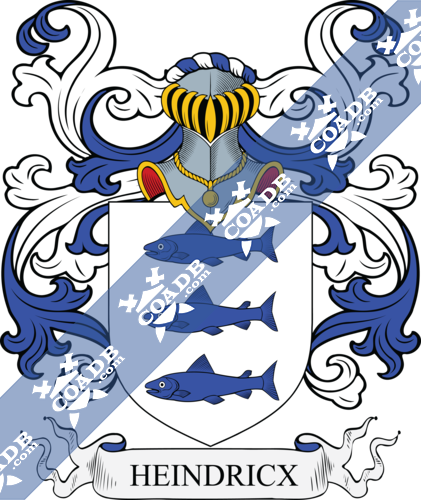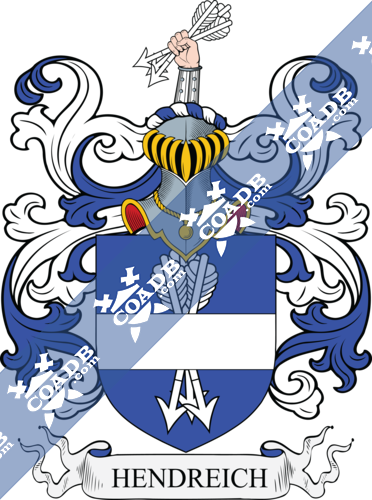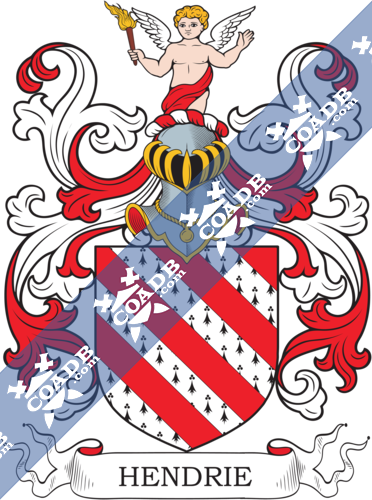Hendrix Family Crest, Coat of Arms and Name History

Hendrix Coat of Arms Gallery
Don’t know which Coat of Arms is yours?
We can do a genealogical research. Find out the exact history of your family!
Learn MoreSurname Name Meaning & Origin
This name, originally Dutch and Scandinavian, and later English, is a baptismal surname meaning “the son of Henry”, from the Dutch Hendrik, with the letter d being intrusive. One author derives it from the ancient personal name Hendrie. Another author derives it from the German personal name Heimric, which means “home rule”. In Ireland, the name either derived from FitzHenry, who were early Norman settlers during the 1100s AD, or from the Gaelic O’Inneirghe, which became anglicized and means “descended from the abandoned one”. The German version of the name was first found in Prussia. One source notes that the surname was first found in Fife, Scotland, and came from an area once rules by the Picts, an ancient Scottish tribe.
Surname Etymology & Spelling
One author notes the name is related to Heynrick or Heymrick, which means “rich at home”. Another Spelling variations include Hendrick, Hendricks, Heindericx, Heindricx, Hendreich, Hendrich, Hendrickx, Hendrikisz, Hendriks, Hendryck, Hendrycx, Henqiues, Hendriks, Hendirk, and several others.
Early Bearers of the Surname
The name is recorded as a personal name (first name) in the Domesday Book, a survey of England and Wales issued in 1086 AD, as Henric. A one Hendricus was first recorded in Staffordshire, England, where in the Abbot Samon of Bury St. Edmunds in 1188 AD. A one Hendrtcus Prid was listed as living in Yorkshire in 1212 AD. The Hundred Rolls of 1273 AD, a census of Wales and England, known in Latin as Rotuli Hundredorum, documents John Hendrich family county Cambridge and William Heneriche from county Oxfordshire. Another early bearer includes Genetiv de Heinrich of Fritzlar in German in 1335 AD. The Visitation of London records one John Henricks, the son of Henry Henrix of Antwerpe, in Brabant, as living during the seventeenth century.
Early American and New World Settlers
The book “Genealogical Guide to the Early American Settlers”, discusses two persons bearing this surname: 1) Daniel Hendrick of Haverhill recorded in 1645. He was born in 1610 and was from Hampton, England. He came to Boston in 1660 with his likely second wife, Mary, the widow of John Stockbridge. With his first wife Dorothy Pike, had the following children: Daniel, John (1649), Jabez, Israel, Hannah, Dorothy, and Sarah and 2) Peter Henrdrick of Windsor in 1675 who went to Walingford in 1712. Other early settlers with this surname include Anna Hendrix (New York 1640), Harmen Hendrix (New York 1660), and Garret Hendrix (Philadelphia 1685). Still others include Hance Hendrick (Virginia 1701), James Hendrick (Maryland 1716), and John Hendrick (Charleston 1821).
Genealogy and Ancestry
In recent times in the New World, the Hendrix line or branch was started by Alexander Hendrix, who was born in Rowan, North Carolina in 1675 AD. He married Mary Elliot in 1697, and had two children with her: Garret Hendrix (1715) and John Hendrix (1715). The next generation included Garrett (1635), Benjamin, Tobias, Andrew, Isaic, and John.
Henry Michael Hendrix was born in the United States in 1791. He married Elizabeth Lewis and had the following children with her before he died in 1875 in South Carolina: Leroy Pascal, Robert, Lucinda, Melinda Elizabeth, Henry Walter, and Sims Frederick. His son, Dr. Henry Walter, was born in 1831 and married Joanna Eve Adelaide Caughman, and they had a child named Henry Walter Jr.
Mottoes
Many families bore Latin or French mottoes, often written into their coats of arms. The family motto for Hendrix or Hendricks and its variants is unknown.
Notables
Famous people who bore the last name include: 1) Jimi Hendrix (1942-1970) the famous black American rock guitarist, 2) Francis Hendricks (1834-1920) who was a banker, merchant, and political from New York, and 3) Thomas Augustine Hendrick (1849-1909) who was an American Catholic Bishop who served in the Philippines.
Blazons & Genealogy Notes
1) Gand – Écartelé aux 1 et 4 d’argent à la fasce d’or ch de trois chevrons rangés de sable et acc en clef de trois merlettes du même () aux 2 et 3 de gueules à la bande de vair (de la Barre) Cimier un cygne d’argent le vol levé. English: Quarterly: 1st and 4th argent a fess or charged with three chevrons sable and accompanied by in chief of three merlettes [without beak or feet] of the same; 2nd and 3rd gules a bend vair; Crest: a swan argent the wings upright.
2) Flandre – D’argent à trois poissons nageants d’azur l’un sur l’autre. English: Argent three fish free-swimming azure, arranged in pale.
3) (ou Hendricx) – Brabant – Écartelé aux 1 et 4 de sable à la fasce d’or ch d’une fasce vivrée de gueules et acc de trois merlettes d’argent rangées en chef (Heindricx) aux 2 et 3 de gueules à la bande de vair. English: Quarterly: 1st and 4th sable a fess or charged with a fess [right angled] dancetty gules, and accompanied by three merlettes [without beak or feet] argent in chief; 2nd and 3rd gules a bend vair.
4) Poméranie – (Ren. de nob., 18 août 1631) – D’azur à un faisceau de trois flèches d’argent à la fasce du même brochant sur le tout Casque couronné Cimier un bras armé en pal empoignant le faisceau de flèches; English: Azure a bundle of three arrows argent, a fess of the same covering overall; Crowned with a helmet – Crest: an arm armed palewise holding in its fist the bundle of arrows.
5) Silésie – De sable à la bande tranchée de gueules sur argent acc en chef d’un lion d’argent couronné d’or; English: Sable a bend per bend gules over argent, accompanied by in chief a lion argent, crowned or.
6) Saxe – Coupé de gueules sur argent chaque compartiment ch d’une poule de sable posée sur un tertre de sinople Cimier un vol coupé alternativement de gueules et d’argent English: Per fess gules over argent each section charged with a hen sable, placed on a hillock vert; Crest: a pair of wings per fess alternately gules and argent.
7) von Schots – Hollande – D’argent à la fasce d’azur acc en chef d’une fleur-de-lis du même et en pointe de deux coeurs de gueules Cimier la fleur-de-lis English: Argent a fess azure, accompanied in chief by a fleur de lys of the same, and in base of two hearts gules; Crest: the fleur de lys.
8) Brabant – D’argent au lion de sable armé et lampassé de gueules English: Argent a lion sable, armed and langued gules.
9) Halle – Coupé au 1 d’or à trois pals de gueules au 2 de sinople à trois macles d’argent Cimier deux bras armés d’argent supportant ensemble une couronne d’or English: Per fess: 1st or three palets gules; 2nd vert three mascles argent; Crest: two arms armed argent, supporting together a crown or.
10) Hollande – De gueules à l’aigle d’argent English: Gules with an eagle argent.
11) Saint-Trond – Écartelé aux 1 et 4 d’or à trois feuilles de houx de sinople aux 2 et 3 d’argent à la fasce de sable de trois merlettes du même English: Quarterly: 1st and 4th or three leaves of holly vert; 2nd and 3rd argent a fess sable between three merlettes [without beak or feet] of the same.
12) Flandre – (Paul ou Heinderycx, échevin de Furnes) (Biographie Nationale de Belgique – D’argent à quatre fusées de gueules en fasce English: Argent four fussils gules in fesse.
13) Flandre – De sinople au chevron d’argent acc de trois oiseaux du même English: Vert a chevron argent, accompanied by three birds of the same.
14) Burges – D’azur à trois épis d’or rangés en fasce feuillés seulement à senestre English: Azure three ears of wheat or, arranged in fess, leaved only to the sinister.




















